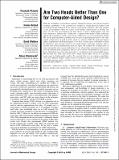| dc.contributor.author | Phadnis, Vrushank Shripad | |
| dc.contributor.author | Arshad, Hamza | |
| dc.contributor.author | Wallace, David | |
| dc.contributor.author | Olechowski, Alison | |
| dc.date.accessioned | 2021-09-15T20:20:55Z | |
| dc.date.available | 2021-09-15T20:20:55Z | |
| dc.date.issued | 2021-05 | |
| dc.date.submitted | 2021-03 | |
| dc.identifier.issn | 1050-0472 | |
| dc.identifier.issn | 1528-9001 | |
| dc.identifier.uri | https://hdl.handle.net/1721.1/131257 | |
| dc.description.abstract | With the availability of cloud-based software, ubiquitous internet, and advanced digital modeling capabilities, a new potential has emerged to design physical products with methods previously embraced by the software engineering community. One such example is pair programming, where two coders work together synchronously to develop one piece of code. Pair programming has been shown to lead to higher-quality code and user satisfaction. Cutting-edge collaborative computer-aided design (CAD) technology affords the possibility to apply synchronous collaborative access in mechanical design. We test the generalizability of findings from the pair programming literature to the same dyadic configuration of work in CAD, which we call pair CAD. We performed human subject experiments with 60 participants to test three working styles: individuals working by themselves, pairs sharing control of one model instance and input, and pairs able to edit the same model simultaneously from two inputs. We compare the working styles on speed and quality and propose mechanisms for our observations via interpretation of patterns of communication, satisfaction, and user cursor activity. We find that on a per-person basis, individuals were faster than pairs due to coordination and overhead inefficiencies. We find that pair work, when done with a single shared input, but not in a parallel mode, leads to higher-quality models. We conclude that it is not software capabilities alone that influence designer output; choices regarding work process have a major effect on design outcomes, and we can tailor our process to suit project requirements. | en_US |
| dc.publisher | ASME International | en_US |
| dc.relation.isversionof | http://dx.doi.org/10.1115/1.4050734 | en_US |
| dc.rights | Article is made available in accordance with the publisher's policy and may be subject to US copyright law. Please refer to the publisher's site for terms of use. | en_US |
| dc.source | Phadnis, Vrushank | en_US |
| dc.title | Are Two Heads Better Than One for Computer-Aided Design? | en_US |
| dc.type | Article | en_US |
| dc.identifier.citation | Phadnis, Vrushank et al. "Are Two Heads Better Than One for Computer-Aided Design?" Journal of Mechanical Design 143, 7 (May 2021): 071401. | en_US |
| dc.contributor.department | Massachusetts Institute of Technology. Department of Mechanical Engineering | en_US |
| dc.contributor.approver | Phadnis, Vrushank Shripad | en_US |
| dc.relation.journal | Journal of Mechanical Design | en_US |
| dc.eprint.version | Final published version | en_US |
| dc.type.uri | http://purl.org/eprint/type/JournalArticle | en_US |
| eprint.status | http://purl.org/eprint/status/PeerReviewed | en_US |
| dspace.date.submission | 2021-09-13T20:26:39Z | |
| mit.journal.volume | 143 | en_US |
| mit.journal.issue | 7 | en_US |
| mit.license | PUBLISHER_POLICY | |
| mit.metadata.status | Complete | en_US |
